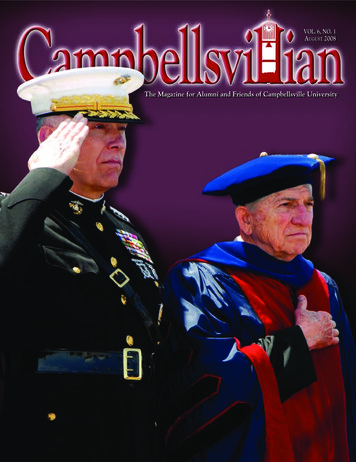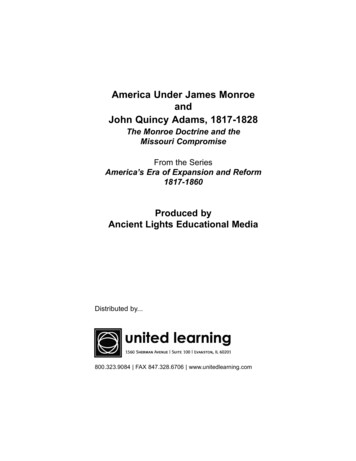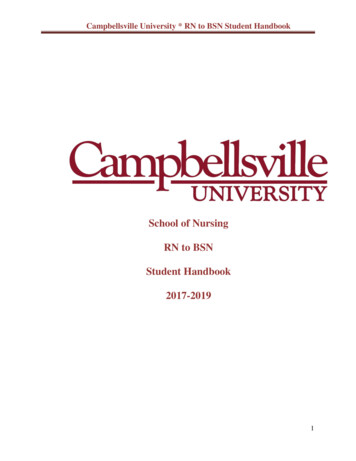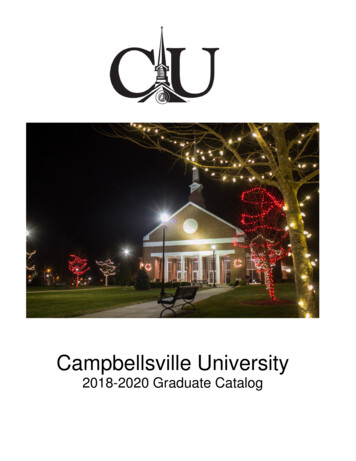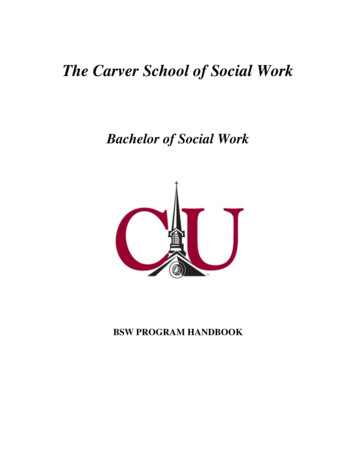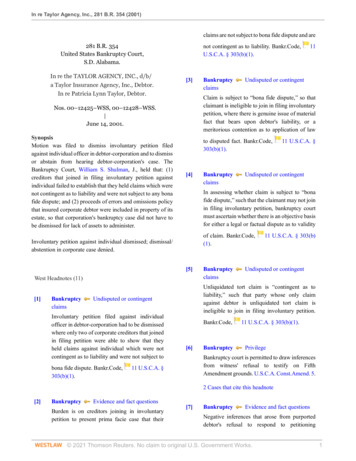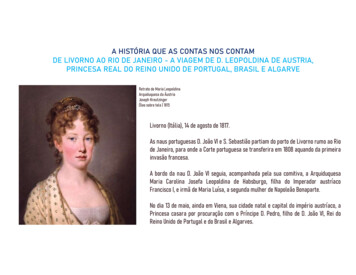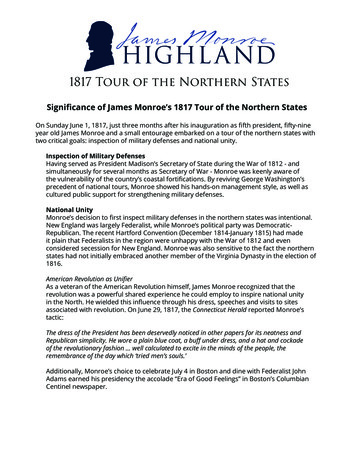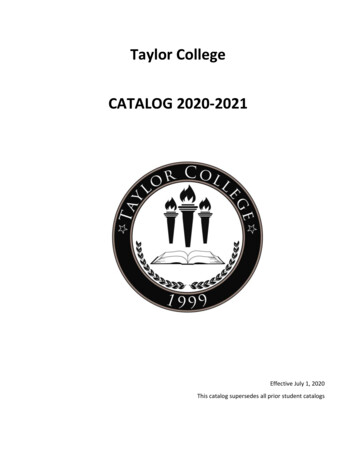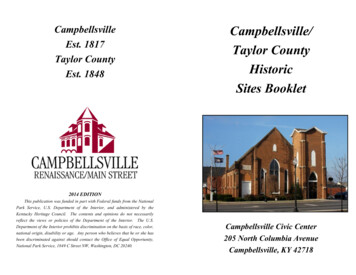
Transcription
CampbellsvilleEst. 1817Taylor CountyEst. 1848Campbellsville/Taylor CountyHistoricSites Booklet2014 EDITIONThis publication was funded in part with Federal funds from the NationalPark Service, U.S. Department of the Interior, and administered by theKentucky Heritage Council. The contents and opinions do not necessarilyreflect the views or policies of the Department of the Interior. The U.S.Department of the Interior prohibits discrimination on the basis of race, color,national origin, disability or age. Any person who believes that he or she hasbeen discriminated against should contact the Office of Equal Opportunity,National Park Service, 1849 C Street NW, Washington, DC 20240.Campbellsville Civic Center205 North Columbia AvenueCampbellsville, KY 42718
Campbellsville/Taylor CountyHistoric Sites BookletDesigned ByMembers of theCampbellsville Renaissance/Main Street/Historic Preservation CommissionCampbellsville/Taylor County KentuckyDoug Tucker, ChairFrank Kidwell, Vice-ChairJim Miller, Secretary/TreasurerDebbie CarterBill ChandlerGreg GribbinsLinda HayesKaren PattonGwynette SullivanMayor Tony Young, Ex-OfficioDonna Logsdon, Ex-officioJudge/Executive Eddie RogersBetty Jane GorinPrinted ByCreative Press1320 Hodgenville RoadCampbellsville, KY 42718
History of CampbellsvilleTaylor County, located in south-central Kentucky, was the 100th county tobe formed in 1848. Surrounded by Green, Larue, Marion, Casey, and Adaircounties, it covers 284 square miles and was named for Zachary Taylor,Mexican War hero and later 12th President of the United States.The City of Campbellsville, which is the county seat, is located 80 milesfrom Lexington, Louisville, Frankfort, and Bowling Green. It was establishedby the Kentucky General Assembly in 1817. Campbellsville was named forAndrew Campbell who made the first town plat. He was one of five brotherswho migrated here from Augusta County, Virginia. The town plat, registeredin the Green County records in 1820, contained 85 lots and a public squarewhere a courthouse was later built. The first school was established in 1836when Adam Campbell sold land on Buckhorn Creek.In the 1830s, Campbellsville served as a stagecoach stop on the NationalMail Route between Zanesville, Ohio, and Florence, Alabama. The stage linesconnecting Lebanon, Campbellsville, Columbia and Greensburg becamefeeder lines to the railroad when it came to Lebanon in the 1850s. After a railspur between Lebanon and Greensburg was opened by the Cumberland &Ohio Railroad in 1879, Campbellsville entered a new era of development. By1890, the population reached 1,018. By 1892, a flour mill, saw mill, and awoolen and carding mill were operating as well as a lumber company, bank,newspaper and two hotels.By 1914, Campbellsville had an electrical power company, gas company,and water works. Fires in 1911 and 1914 destroyed many of the town’s earlybuildings. In 1948, the Union Underwear Company came to Campbellsvilleand spurred economic growth. By 1989, the plant that manufactured Fruit ofthe Loom products was the world’s largest producer of men and boys’underwear and the second largest textile plant in the U.S. The plant closed in1998.Campbellsville is an important manufacturing, medical and recreationalcenter in south-central Kentucky. It is a third-class city with a 2014 estimatedpopulation of 10,000.
Historic Walking/Driving TourMap of Downtown Campbellsville1CAMPBELLSVILLE CIVIC CENTER205 North Columbia AvenueThis Gothic Revival style building was built in 1889 as theCampbellsville Baptist Church. The Cumberland PresbyterianChurch bought it in 1916. An educational annex was added in 1955.The City purchased the building and converted it into the TaylorCounty Public Library which opened in 1975.Historically, a wood-frame Baptist Church was located herewhere Union soldiers were cared for during the measles andtyphoid epidemics that hit Civil War training camps in the fall andwinter of 1861-1862. It also served as a courthouse after the TaylorCounty Courthouse was burned during the Civil War.
2OLD TAYLOR COUNTY CLERKS’ OFFICENorth Columbia AvenueConstructed in 1865, this late Federal-style building was built tohold county records after Confederate General Hylan B. Lyon set fireto the courthouse on Christmas Day 1864. Until a new courthousewas erected, county court was held here. The Taylor CountyHistorical Society currently occupies the building that was listed inthe National Register of Historic Places in 1977.3TAYLOR COUNTY COURTHOUSE203 North Court StreetThis is the third courthouse on this site. The first courthouse,constructed in 1848, was burned in 1864 by Confederate Gen. H.B.Lyon. He allowed the county records to be removed before setting itafire. At the start of the war, Federal soldiers camped around thecourthouse and slept on the brick floors. Dinners were prepared fortroops and served on the grounds. When the war was over, a onestory brick courthouse was completed in 1867 on the square’s eastend. A clock tower and second floor were added in 1910. Thepresent 1965 building replaced the 2nd courthouse.41THE HOMEPLACE5807 New Columbia RoadThe Homeplace on Green River is an educational farm inCampbellsville, KY that has been designated as “Kentucky’s OutdoorClassroom”. It is a 227 acre farm being restored as a permanentreminder for all ages of the role agriculture has played and iscontinuing to play in the lives of South Central Kentuckians.It has been a working farm for more than 200 years and is listedthe National Register of Historic Places. The Homplace on GreenRiver is adjacent to the Tebbs Bend Battlefield and the Tebbs BendGreen River Nature Area.The original home was built in 1803 by Isaac Tate and wasexpanded by the owners that followed.
3919402014CAMPBELLSVILLE UNIVERSITY1 University DriveFounded in 1906 as Russell Creek Academy, the school becameCampbellsville Junior College in 1924, a four-year college in 1959,and Campbellsville University in 1996. The ten acres of land, oncethe town's best blackberry patch, was purchased from CharlesHoskins for 1,000. The land contained a brickyard. It providedbricks for the construction of the Administration Building, StappHall, and gymnasium from the bricks that were made on-site inJanuary 1920. During the 1920s, buggies deposited students atStapp Hall in front of its long double- veranda porches. The collegeoperated both an elementary school and a high school, which wereterminated in the 1930s. The school farm once reached up toCoakley Street and maintained its own gas well.Its three-story Administration Building burned in 1939 and thepresent one was constructed in 1940. Maple trees, planted yearsago, still line its entrance.4WVLC-BIG DAWGCoca Cola, Scott’s101 East Main StreetThis Italianate style building, built between 1876 and the early1900s, was occupied by the Taylor County Enquirer in 1900, CocaCola Bottling and Louie the Greek Bar in the 1920s, and later byScott's, Cato’s, and Rusty Tungate's Grill. It is now the home of aradio station WVLC, known as The Big Dawg.540ATKINSON-GRIFFIN HOUSEGreen River LakeCorp of Engineers Visitors CenterThe Atkinson-Griffin Log House is an 1840 log building whichcontains a diorama of the Battle of Tebbs Bend and a gallery ofphotographs of the 25th Michigan and John Hunt Morgan’s SouthernCavalrymen. This building served as a Confederate Hospital afterthe Battle of Tebbs Bend was fought July 4, 1863. It was said thatthe “blood ran from the front yard into the turnpike road.” Thehouse museum is located adjacent to the Green River LakeInformation Center.THE NEW TURNER BLOCK103-109 East Main StreetRedman’s Tavern was on this site from the 1840s through the1860s. General John H. Morgan’s headquarters were here NewYear’s Eve 1862. At 103, was the Taylor, Pruett & Jarvis DepartmentStore. McKnight's Pharmacy was located here during the 1950s and1960s. Currently, Nunery Law Office occupies the building. At 105,between 1910 and 1930, Buchanan-Lyon sold hardware, buggies,and wagons, followed by the first Ford agency in Campbellsville.Lerman’s Department Store sold cloth, clothing and shoes from1924 to 1989. On the second floor, during the Depression, the WPAfinanced a night-time recreational program for youth where boxingmatches took place.
6BENNETT LAW OFFICEBank of Campbellsville111 East Main StreetBegun in 1887 as Campbellsville’s first bank, the Bank ofCampbellsville served the community until its collapse in 1939.Taylor County Federal Savings & Loan Association used it until 1965.A clothing store and Margaret Ann’s Gifts and Flowers have sinceoccupied the building. In 1901 a cigar factory operated on thesecond floor. By 1915, the Telephone Exchange was there.Currently, the first floor is occupied by Bryan Bennett’s Law Officeand the second floor is a private apartment. At the top of thebuilding are the words “BANK OF CAMPBELLSVILLE”.7SHARLOW & ASSOCIATES, CPA115 East Main StreetThis two-story brick Italianate style building, constructed in theearly-1800s, was known as Wood’s Corner Store for the originalowner, James M. Wood. Judge John W. Cloyd and Frank P. Turnerran a general store here until Turner sold his interest to Cloyd in1890. Cloyd opened the town’s first chain store, Quaker MaidGrocery, until the A&P took over and moved it. Ray Taylor operatedthe Western Auto here followed by Chester and Ina Blakemanbetween 1958 and 1980. Rainey’s Pawn Shop operated here until2011. Currently, Sharlow & Associates, CPA occupy the building onthe first floor with an apartment on the second floor.38CLAY HILL7250 Old Lebanon RoadClay Hill, an 1835 Greek-revival house, was built by JamesSanders, son of Henry Sanders, who began operating nearbySanders Tavern in 1797. The home is privately owned. The Clay Hillfarm nurtured eight generations of the Sanders family for 200 years.During the Civil War, Confederate Gen. John H. Morgan soughtinformation from its residents on his Pleasant Hill Raid.Troops from both the North and South camped on its grounds.The adjoining Clay Hill Memorial Forest of 158 acres was a gift toCampbellsville University by the Sanders family. It contains fivemiles of forested hiking trails, the Joan White Howell EnvironmentalEducation Center, the Ken Weddle Center for Sight ImpairedChildren, a small arboretum, pond, grass prairie, streams andsprings, and is open to the public.
37HIESTAND HOUSE-TAYLOR COUNTY MUSEUM1075 Campbellsville BypassHodgenville RoadJacob Hiestand, born in York County, Pennsylvania, married EveLandis in Botetourt County, Virginia. After living in Highland County,Ohio, they moved to Kentucky about 1816 and built this home in1823. Their daughter, Araminta, who was married to State Rep.Joseph H. Chandler, was living in the house when it was raided byConfederate Gen. John Hunt Morgan's men. She defended thehouse with her shotgun. The Chandlers continued to dwell thereuntil 1873. During the next 100 years, the principal owner of thehouse was the Gilmore family.In 1988, the house was threatened by the development ofGreen River Plaza. The house and cemetery were moved one-halfmile north and reconstructed. Presently restored parts of theplantation are the stone house, detached kitchen, gardens, springhouse, and log servant quarters. The house is an example of thebest houses in the region during the settlement period of Kentuckyand is listed in the National Register of Historic Places. Exhibits inthe Servants Quarters include a banner dedicated to Taylor CountyAfrican-Americans of Achievement. Other exhibits portray countyhistory, textile history, and tools and country stores from the area.8CAULK HARDWARE117-119 East Main StreetThis two-story Italianate style brick building was constructed in1885. A cistern remains in its central courtyard where horses couldbe watered. It was particularly used during County Court Day.Coakley and Durham Dry Goods occupied the building from 1888 tothe early 1900s. Caulk Appliance and Caulk Hardware began hereabout 1940. Snappy Tomato Pizza occupied the left half recently.A hardware store occupied the right side since 1885. CaulkHardware, a Porter Paint dealer, was its long-time occupant in thelatter 20th century. In recent years, the Tulip Tree store was locatedhere.9TUCKER DIAMONDS AND GOLD121-123 East Main StreetThis Victorian Italianate style building was constructed in 1885by Samuel R. Bass. Originally a millinery shop was located in theright half in 1895 followed by the Farmer’s Deposit Bank in 1902.Later Wilkerson’s Restaurant occupied the site. O.B. Finn sold colddrinks, medicines, perfumes, tobacco, silverware, and books.Young's Jewelry, later known as Tucker’s Jewelry, was here from1948-1980. Maxine’s Discount Shoes occupied the building until2011. Candy Bouquet followed. Tucker Diamonds and Gold movedto the left half of the building in 1948 and currently own the entirebuilding.
10MERLE NORMAN125 East Main StreetConstructed between 1876 and 1883, the Phillip, Putnam andCompany, a general store, occupied the building between 1886 until1915. Davis Brothers Hardware followed and sold farm implementsat its rear entry. Clyde Williams Law Office and Johnny Burkholder'sInsurance Agency were upstairs. Penn-Ratcliffe Hardware was herein the 1950s, followed by Lay-Simpson Furniture in the 1970s. Sincethe 1980s, Merle Norman modernized the main entrance with aflared metal roof to emphasize its corner entry.11HISTORICAL SITECITIZENS BANK - 2014201-209 East Main StreetFerdinand J. Hiestand operated a tavern on this site in the1840s-1850s. In 1905, Chandler & Davis Hardware operated in 201.Two major fires between 1910 and 1915 caused extensivealterations on this block. The current building was completed in1914. Taylor National Bank, known as the Gowdy Bank, occupiedthe building from 1914 until it closed in 1937 under the ownershipof T.O. Morton.Citizen’s Bank has occupied this site since 1939. Originally, thisbuilding was four stories tall until a fire in 1961 destroyed the topfloors. In 209 was a 1940’s teen hangout, Walgreen’s Drug Store.Letha’s Dress Shop and Scott’s followed there. Dr. C.V. Hiestand andDr. James Conover offices were upstairs over 209. Dr. Hiestandpracticed in the county for 70 years first driving a horse and buggyand then wearing out 27 cars. Hobbs 5 & 10, Taylor County Supply,and Brack’s were next in the block.36BATTLE OF TEBBS BEND327 Tebbs Bend RoadA stunning Union victory was the result of the Battle of TebbsBend of Green River, fought July 4, 1863. Five companies of Col.Orlando H. Moore's 25th Michigan Infantry were attacked byConfederate Gen. John Hunt Morgan's cavalrymen on a hotSaturday morning and were engaged in a 4-hour fight for GreenRiver Bridge. The Rebels charged the Union defensive line eighttimes but Michigan men held their position. The Confederatesbegan to run out of ammunition and suffered heavy casualties. Theywithdrew through Lemmon's Bend and continued moving north.The hungry Southerners raided houses and took fresh mountsas they moved through Campbellsville. That evening, the troopscamped at New Market near Lebanon, where another fierce battleoccurred the following day.After his Great Raid through Kentucky, Indiana, and Ohio,Morgan was captured on July 26, 1863. Tebbs Bend was one of thebloodiest battles on the Western front for so few men involved.Morgan lost over 20 of his officers killed or wounded in this conflict.His men are buried in a mass grave under the ConfederateMonument. Memorial stones have been erected in the Confederatecemetery. The bodies of six Michigan troops rest in LebanonNational Cemetery.
1234MERCHANT TOWERMerchants Hotel102 East Main StreetThe Merchants Hotel was constructed in 1910 by a corporationcontrolled by B.S. Breeding (1858-1933) to house drummers orsalesmen that came to Campbellsville. It provided meals andlodging for traveling salesmen and was the social center for localresidents. The building consisted of a lobby and thirty-two rooms.In its heyday, it was a leading hotel in the area and the parlor onthe second floor became a popular recreation spot. DuringProhibition, liquor was served in a room called the “Blind Tiger.”After 1935, the hotel became a rooming house. It was listed inthe National Register of Historic Places in 1980.Historically, this site was occupied by the Leet Hotel, whichburned followed by a merry-go-round run by Joe Willock.GOWDY BLOCKAlhambra Theatre219-229 East Main StreetHistorically, 219 and 221 East Main Street were the site of theCommercial Hotel, owned by C.W. Wright, later by C.B. Bailey andJ.B. Montgomery. Cockerell Barber Shop was inside the hotel. In1911, a fire destroyed this entire block. George Gowdy rebuilt theblock between 1911 and 1918. The Alhambra theatre operated at219 for almost 50 years, until 1964. Saturday afternoon matinessconsisted of cartoons and a cowboy movie. In the 1940’s for 25cents one could purchase a coke and popcorn. Marcum's 5 & 10,Brenda's Sewing Center in the 1980s, and Murphy Sleep Center in2010 previously occupied the building. Currently, Sallee’sTaekwondo offers self-defense courses here.1335GRAVE SITE OF ANDREW CAMPBELLWest Main StreetAndrew Campbell and his brothers came to this area fromVirginia in the early 1800s and by 1814 Andrew began selling townlots. He lived adjacent to Buckhorn Creek where he operated a gristmill. During the Civil War Union soldiers watered their horsesalongside the creek. In January 1862, the 2nd Minnesota Infantry,on their way to confront CSA General Zollicoffer’s forces at MillSprings, camped in the area for five days. The government stable forU.S. horses was across the street where Morris Carpet is today.MITCHELL’S MEN’S WEAR221 East Main StreetMitchell’s Men’s Wear is the 2nd oldest continuously operatingbusiness in Campbellsville. The business moved to its presentlocation in 1919 when this building was constructed.A cistern is at the back of the store. Owners Lynn and MattieMitchell opened the store with brother-in-law Dan Hatcher in 1910.In 1946, Lynn, Jr. and Billy Mitchell took over the store. In 1929,when Billy Mitchell was 9 years old, he kept the store open while hisparents ran across Main Street to see an airplane crash behind theJustice Center which involved his mother’s nephew. In 1990, LauraMitchell Wilds returned to town and continues the threegenerations of family members who have continuously owned andoperated this store since it opened. The store sells men’s andwomen’s wear.
14HAPPY DAYS ALL AMERICAN GRILL227-229 East Main StreetAbout 1900, J. Walter Coakley operated a grocery on thiscorner. The present building was constructed after the 1911 firewhich destroyed the block. Pruitt & Leachman Drug, the CornerDrug Store, Hobby Shop, and Pierce Portrait Studio once occupiedthe building. Today, Happy Days All American Grille operates here.Stella's Beauty Shop was upstairs over Happy Days.227 East Main Street was Norman Hobson Grocery in 1905, JoAnn Dress Shop, Dearen's Dress Shop, Mrs. Davis's Beauty Shop,Supertone Studio, now Mending Thimble sewing shop.15WISE BUCKNER SPROWLES ASSOC. PLLC301 East Main StreetThis was originally the site of the large home of Dr. SamChandler. During the Civil War, knowing he be captured and forcedto serve in the army, he got in bed with his newborn baby andpretended to be its mother. Built between 1896 and 1908, thepresent two-story sandstone building with marble base had adiagonal corner entry in 1908 and housed the Hord and HallHardware Store with a tin shop in the rear. The Telephone Exchangeoccupied the second floor.Taylor County Bank opened on this site in 1937 and remainedhere until its move to the corner of Broadway and Lebanon Avenue.Wise and Lee followed; then Wise, Lee and Buckner; now WiseBuckner Sprowles.33WILLOCK BUILDING110-112 East Main StreetJoe Willock, who began Coco-Cola in Campbellsville in 1905,constructed this building for commercial purposes in 1908. TheEconomy Store-the town's first dime store with a long candycounter was on the first floor. An Opera House was on the secondfloor, and a meeting room for the Pitman Masonic Lodge was on thethird floor with stages around the room’s perimeter. In the 1940’s, adime could purchase a sack full of chocolate covered peanuts and anickel could purchase a Hershey bar at the Economy Store.The Hatcher-Mitchell Men’s Store, now Mitchell’s Men’s Wear,occupied the first floor in 1911. Buchanan-Lyon Hardware occupiedthe building between 1915 and 1916. Kentucky Utilities was locatedin 110 and Russell Stores in 112 during 1924, later, the Tuner Store.The motion picture show began on the 2nd floor in February 1911.Vaudeville acts, amateur talent shows and other stageentertainment played on the 2nd floor until it became a skatingrink.During the 1930s, U. V. Walker had an undertakingestablishment on the 2nd floor. When Tennessee Gas Transmissionmoved into the county in the late-1930s and early-1940s, the 2ndfloor was partitioned into rooms and rented out due to a housingshortage. These partitions remain intact. A back room was used asthe dining hall and is separated from the front by a small dressingroom with a balcony above it.
1631BROTHERS BARBEQUE128 East Main StreetThis two-story brick building was constructed in 1895. Coakleyand Durham is written in black and white tile at the recessed frontentrance. By 1895, D.W. Gowdy's General Store occupied the firstfloor with clothing and furnishings on the second floor. Gowdyowned the building from the late 1800s until the early 1900s.Buchanan & Sanders opened a hardware store here in 1900 whichlater became Coakley and Durham Dry Goods (c. 1922-1930). Thebuilding housed the Firestone Store from the 1940s to the 1970s,then Broadway Appliance, Café Bonin, and now Brothers Barbeque.JANICE HOLT GILES106 North CentralJanice Holt Giles, writer of note, was married to Henry Giles.Upon his employment at the Campbellsville News-Journal, Henryand Janice moved to 106 North Central. From the fall of 1955 untilJanuary 1957, they lived in a spacious, second-floor apartment overthe Topper Restaurant. Here, she penned her most famous novel,The Believers, a story about a young couple who join the Shakercommunity. Insightful, she gives the reader a window into everydaylife among the Shakers. The Topper was razed in 2001 and replacedby the Methodist Church Annex in 2006.1732SAPP’S ANTIQUES116-120 East Main StreetAt 116 East Main Street, the Coca-Cola Bottling began in therear cellar in 1905. On the first floor, the News-Journal waspublished for many years, beginning 1910. W.R. Hoskins Grocerywas here. In 118-120 were Monson's Department Store, CaulkFurniture followed by Galleries, Stephens Furniture, and Ann'sDance. Sapp's Antiques occupies the entire space at present.DIXIE ATLAS REPUBLIC INSURANCECOMPANY BLOCK303-311 East Main StreetThese three two-story brick buildings, built between 1908 and1915, belonged to the Dixie Atlas Republic Insurance Company inthe 1920s and 1930s until the company went bankrupt in 1933. At303, Ben Shapira began a dry goods business in 1913, followed byPurcell's in the 1960s and 1970s. Between 1908 and 1928, localnewspapers were located in one or more of the buildings. Later,stores operated by Joe Callison and H. H. Montgomery Grocery,David Gowdy's Store, Miller's Dry Cleaners, the Cozy Theater, ShirtCity, a fabric shop, Boone’s Antiques and People’s Barbershopoperated by Tom Hodgen were some of the occupants of thesebuildings.
18COZY THEATRECOZY COMFORTS305 East Main StreetBuilt between 1908 and 1915, it was one of three buildingsowned by the Dixie Atlas Republic Insurance Company. A grocerystore was here the early 1930s. In 1936, General Electric productswere sold here. An automobile sales room showcased Chrysler andPlymouth cars. In 1945, the Cozy Theatre opened to featuring fourshows of “The Town Went Wild.” The Cozy Theatre closed and waslater reopened in 1956 with a wide vision screen. In 1976, the movie“Jaws” was featured here. Since 1989, Cozy Comforts, has occupiedthe building.19FIRST UNITED METHODIST CHURCH317 East Main StreetOriginally, this was the site of several log houses until theMethodists built the present two-story brick First United MethodistChurch building in 1921. The land was donated by W.S. Hill, EdwardHill, and A.C. Hill. Pastor Rev. J.L. Piercy presided and the chiefarchitect and contractor was J.T. Phillips.The central portico is supported by tapered stone columns. Alarge round stained glass window pierces the façade. The bell towerhas been removed. The building was remodeled after a fire in 1940.In 1977, the building to the west was converted into an educationalbuilding and fellowship hall.29CHANDLER BUILDING202 East Main StreetThis two-story brick Italianate style building has the name“Chandler” and the date “1893” in the pediment. In 1895, it was ageneral store with clothing on the second floor. Hill Brothers DryGoods was there from 1910 until the 1920s. Scott and Smith DryGoods which later became Scott’s Ladies Apparel followed. Hobb’sVariety Store occupied the building in the 1960s and the 4 Season’sSport Shop during the 1970s and 1980s, then Burton’s Pawn Shop.30THE GREEN ROOM130 East Main StreetBuilt between 1876 and 1882, this building has stone sills, tinwindow hood molds, and cast iron pilasters from George L. Mesker,Evansville, IN. Brick corbelling and a decorative metal parapetaccent this Italianate style building.Dr. W. T. Chandler ran a drugstore on the site from the 1880suntil the early-1900s. By the 1930s, Garland Shipp ran a restauranthere, followed by a series of poolrooms, the Smock craft shop, W. R.Knifley Wholesale Grocery, where the cigarette tax was still beinghand stamped on the packs, Gray’s Shoe Store, the News-Journal,Creative Press, and Main Street Memories, an antiques shop.Currently, the Green Room, a Day Spa, occupies the building.
27STULTS BUILDING212 East Main StreetBuilt 1895, this building originally housed J. “Jack” S. Stults DryGoods. Pruitt, Wilkerson & Co. General Store was in the building in1909. Tom Taylor ran a business here which later moved andbecame Taylor, Pruitt & Jarvis. Norman Hobson moved into thebuilding circa 1910 and ran a grocery store which burned in the1911 fire. Hobson sold the grocery store to Clarence Hartfield in1912. The Campbellsville Barber Shop followed. In 1954, thebuilding housed King’s Department Store. Between the 1960s and1990s, it was Winn’s Store for Men. Dr. Richard Allen Sanders, I,and Richard Allen Sanders, II, had their dental offices upstairs in thisbuilding. Currently the building is being renovated.28CHANDLER’S OFFICE SUPPLY208-210 East Main StreetIn 1894, contractor Charles A. Bridges Sr. built 208 East MainStreet. In 1908, a hardware store was located here followed by apoolroom and dress shop. Today, Chandler’s Office Supply occupiesthe building.Chandler’s Novelties, Main Street’s oldest continuous businessat 210 East Main Street, was built in 1892. This general store oncehad a lunch counter. In the 1950s, children purchased their schoolsupplies, residents bought wedding gifts and hallmark cards andfarmers and gardeners bought seeds here. In recent years, the storehas expanded to 208 East Main Street. Historically, Dr. Milton Elliottfollowed by Dr. Don Bernard occupied office space upstairs.20BERTRAM COX & MILLER321 East Main StreetOriginally, this was the site where the stage coach was kept. TheBorders Home, then a Doctor’s Office Building, and the J.R.McRoberts Home followed. In 1936, the former U.S. Post Office wasbuilt here containing two Bert Mullins murals, one depicting ZacharyTaylor in the Seminole War and another one with an agriculturaltheme. Today, the old post office building is occupied by Bertram,Cox and Miller Law offices.21LYON-DEWITT-BERRY FUNERAL HOME, INC.503 East Main StreetOriginally this was built in 1873 as the home for attorneyJoseph Harrison Chandler and his wife Araminta Hiestand Chandler.It is the oldest residence on East Main Street.22BETHEL FIRST PRESBYTERIAN CHURCH502 East Main StreetIn 1882, the Campbellsville Presbyterians constructed a churchon East Main Street. In May 1884, the new church was dedicated.in 1892, it was destroyed by fire and reconstructed in the GothicRevival style. A Sunday school annex with a basement wasconstructed in 1921. The sanctuary was remodeled in 1970. TheFellowship Hall and Sunday school rooms were added in 1980.
23INGRAM HOUSE402 East Main StreetThe Ingram House was originally built in the 1870s for ThomasIrvine. This Italianate house has remained in the same family sinceits construction. It originally featured a long porch with gingerbread.24CIVIL WAR SKIRMISHMain Street was the site of a Civil War skirmish. HenryMagruder joined the Southern forces and served with John HuntMorgan until Morgan’s capture on the Great Raid in 1863. Duringthe rest of the war, he led a group of Confederate guerrillascapturing stages and trains and damaging federal property.In November 1864, Magruder and about 15 followers came toTaylor County. They murdered at least two members of the 13th Ky.Cavalry after they had surrendered and robbed the local citizenry oftheir watches and money. In the middle of pillaging, a stage loadedwith passengers came to town. Some of the men on the stage weremembers of Battery B, 1st KY Artillery. Being told what washappening in the lower part of town, they took cover in a house.There was a shoot-out on Main Street and Magruder’s gang“skedaddled.”Magruder’s terror came to an end when he was captured withJerome Clark (Sue Munday) on a farm in Hancock County. BothMagruder and Clark were hanged.25NEWTON BLOCKThe Elegant Touch and Glitz222-226 East Main StreetBuilt circa 1886 as the Newton Block by Sylvester and “Abe”Newton, it contained the Newton Hotel. Around 1895, there was agrocery store. In 1900, the Campbellsville Hotel was located herethrough 1927. Charles Wright practiced law here.In 1908, a post office maintained space in the Main and Central
CAMPBELLSVILLE UNIVERSITY 1 University Drive Founded in 1906 as Russell Creek Academy, the school became Campbellsville Junior College in 1924, a four-year college in 1959, and Campbellsville University in 1996. The ten acres of land, once the town's best blackberry patch, was purchased from Charles Hoskins for 1,000. .
